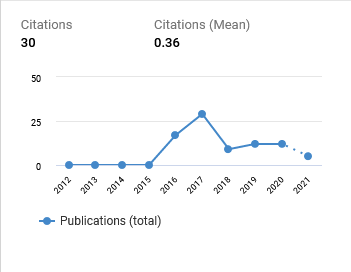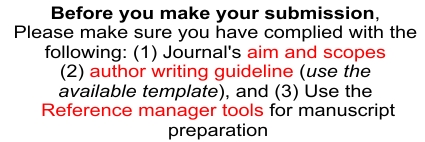Investigating Individual Spontaneous Behavior During Natural Disasters: Inside and Outside the Building
DOI:
https://doi.org/10.29080/eija.v6i2.1084Keywords:
natural disaster, human behavior, spontaneous behaviorAbstract
Indonesia is prone to natural disasters that can occur unexpectedly and gradually. Natural disasters implement surprising impacts due to a lack of awareness and preparedness in facing the threats. One of the reasons caused by such a disaster that can be seen is through human behaviour. Human behaviour is challenging to predict in an emergency, stressful and chaotic. Spontaneous behaviour is distinguished by location factors, indoor or outdoor, with indoor, divided by Home and Public Building. This research aims to reveal spontaneous human behaviour during natural disasters while inside and outside the building. This research was conducted with a qualitative exploratory method. Data were collected using an online questionnaire with open-ended questions and distributed freely. The findings show tendencies to withstand when in the public building while going to distance themselves from building while at home, as for those outdoor opt to surrender as not to do anything
Downloads
References
Archea, J., & Kobayashi, M. (1983). The Behavior of People in Dwellings During the Off-Urakawa Earthquake of 21St March 1982. Disasters, 7(4), 312–312. https://www.safetylit.org/citations/index.php?fuseaction=citations.viewdetails&citationIds[]=citjournalarticle_35438_35
Benthorn, L., & Frantzich, H. (1999). Fire alarm in a public building: How do people evaluate information and choose an evacuation exit? Fire and Materials, 23(6), 311–315. https://doi.org/10.1002/(SICI)1099-1018(199911/12)23:6<311::AID-FAM704>3.0.CO;2-J
Creswell, J. W. (2013). Qualitative Inquiry and Research Design: Choosing Among Five Approaches (Third Edition). SAGE.
Fahrevy, Sari, S. A., & Indra. (2014). Kajian Tingkat Pengetahuan Kepala Keluarga Dalam Menghadapi Bencana Gempa Bumi Di Kecamatan Baitussalam Kabupaten Aceh Besar. Cakradonya Dental Journal, 6(2), 737–744. http://www.jurnal.unsyiah.ac.id/CDJ/article/view/10430
Firmansyah, I. (2014). Hubungan pengetahuan dengan perilaku kesiapsiagaan dalam menghadapi bencana banjir dan longsor pada remaja usia 15-18 tahun di sma al-hasan kemiri kecamatan panti kabupaten jember. http://repository.unej.ac.id/handle/123456789/56880
Fujisaki. (1979). Miyagi-ken-oki Earthquake and Medical System. Newsletter of Miyagi Medical Association, 446–456.
Goto, Y. (2011). Fact-finding about evacuation from the unexpectedly large tsunami. Proc. of One Year After.
Haryadi. (2010). Arsitektur, lingkungan, dan perilaku: Pengantar ke teori, metodologi, dan aplikasi. Gadjah mada University Press.
Huo, F. Z., Song, W. G., Liu, X. D., Jiang, Z. G., & Liew, K. M. (2014). Investigation of Human Behavior in Emergent Evacuation from an Underground Retail Store. Procedia Engineering, 71, 350–356. https://doi.org/10.1016/j.proeng.2014.04.050
Kumar, R. (2018). Research Methodology: A Step-by-Step Guide for Beginners. SAGE.
Kurniawati, D., & Suwito, S. (2017). PENGARUH PENGETAHUAN KEBENCANAAN TERHADAP SIKAP KESIAPSIAGAAN DALAM MENGHADAPI BENCANA PADA MAHASISWA PROGRAM STUDI PENDIDIKAN GEOGRAFI UNIVERSITAS KANJURUHAN MALANG. JPIG (Jurnal Pendidikan Dan Ilmu Geografi), 2(2), Article 2. https://doi.org/10.21067/jpig.v2i2.3507
Murakami, H. O., & Durkin, M. E. (1988). Studies of occupant behavior in earthquakes review and perspectives. STUDIES, 13, 3–1. http://www.iitk.ac.in/nicee/wcee/article/9_vol7_681.pdf
Odani, M., & Uranaka, K. (1999). Road block in area affected by the great Hanshin-Awaji earthquake and influence of blockage on traffic flow. Journal of the Eastern Asia Society for Transportation Studies, 3(6), 151–164.
Ohta, Y., & Ohashi, H. (1985). Field Survey on Occupant Behavior in an Earthquake. International Journal of Mass Emergencies and Disasters, 3(1), 147–160. https://www.safetylit.org/citations/index.php?fuseaction=citations.viewdetails&citationIds[]=citjournalarticle_56018_35
Okabe, K., & Hirose, H. (1985). The General Trend of Sociobehavioral Disaster Studies in Japan. International Journal of Mass Emergencies and Disasters, 3(1), 7–19. https://www.safetylit.org/citations/index.php?fuseaction=citations.viewdetails&citationIds[]=citjournalarticle_56019_38
Rapoport, A. (2016). Human Aspects of Urban Form: Towards a Man—Environment Approach to Urban Form and Design. Elsevier.
Sagun, A., Anumba, C. J., & Bouchlaghem, D. (2013). Designing Buildings to Cope with Emergencies: Findings from Case Studies on Exit Preferences. Buildings, 3(2), 442–461. https://doi.org/10.3390/buildings3020442
Song, X., Zhang, Q., Sekimoto, Y., & Shibasaki, R. (2014). Prediction of human emergency behavior and their mobility following large-scale disaster. Proceedings of the 20th ACM SIGKDD International Conference on Knowledge Discovery and Data Mining, 5–14. https://doi.org/10.1145/2623330.2623628
Ursano, R. J., McCaughey, B. G., & Fullerton, C. S. (1995). Individual and Community Responses to Trauma and Disaster: The Structure of Human Chaos. Cambridge University Press.
Yun, N.-Y., & Hamada, M. (2012). Evacuation behaviors in the 2011 Great East Japan earthquake. Journal of Disaster Research, 7(7), 458–467.

Downloads
Published
How to Cite
Issue
Section
Categories
License
- Authors retain copyright and grant the journal right of first publication with the work simultaneously licensed under a Creative Commons Attribution ShareAlike License that allows others to share the work with an acknowledgment of the work's authorship and initial publication in this journal.
- Authors are able to enter into separate, additional contractual arrangements for the non-exclusive distribution of the journal's published version of the work (e.g., post it to an institutional repository or publish it in a book), with an acknowledgment of its initial publication in this journal.
- Authors are permitted and encouraged to post their work online (e.g., in institutional repositories, pre-print sites, or on their website) prior to and during the submission process, as it can lead to productive exchanges, as well as earlier and greater dissemination of published work.
































